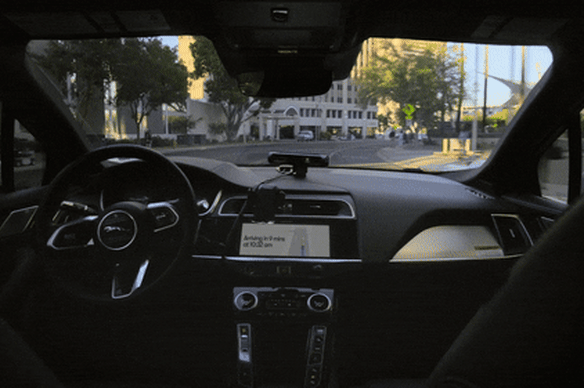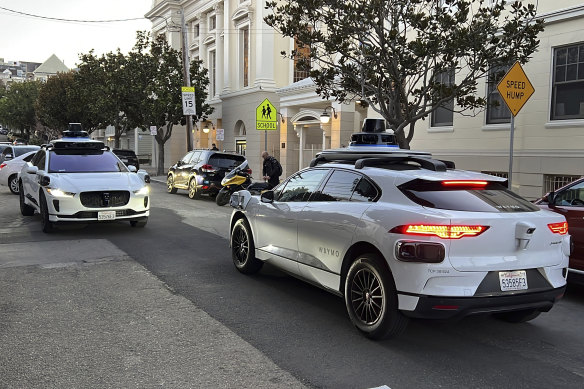This was published 7 months ago
Opinion
I can’t wait for driverless taxis to arrive in Australia
Gary Nunn
ContributorQuestion. Would you ride a self-driving cab? “Robotaxis” already exist – they’re ubiquitous in San Francisco (where else?) – but some find this Silicon Valley innovation alarming. Even those brave enough to ride in them report feeling unnerved on their first trip.
Personally, I cannot wait for them to come to Australia.
Park, for one second, potential logistical problems, such as Sydney’s and Melbourne’s CBD streets not being wide enough. The same was said of the glorious bicycle lanes I now zip along. As Henry Ford said: “If I’d asked customers what they wanted, they’d have said ‘faster horses!’”

Waymo driverless cabs have become more conspicuous on the streets of San Francisco. Credit: YouTube
On a recent, nail-biting share-ride trip, my friend and I asked the (clearly overworked) human driver to pull over; he was visibly nodding off and risked veering into oncoming traffic. My friend offered water spray to wake him up.
Driverless cars don’t get sleepy. They don’t text or drink and drive, or get road rage, or harbour prejudices (against cyclists, for instance). They don’t get distracted by music, weather, passengers, phone notifications, noise or someone hot walking past.
The worst that seems to have happened so far is the horns of about 30 driverless cabs, stationed in a car park, started honking simultaneously in the middle of the night. Admittedly, it conjures a dystopian scene of humanless cacophony, but the company says it fixed that software glitch. And nobody died.
I’d much rather get in a self-driven cab or car than a human-driven one. Yet I feel like I’m in a distinct minority. This could see the biggest shake-up of taxi transportation since Uber’s arrival. It may well put Uber’s current model out of business. But if the reactions of Australians are anything to go by, the moment might take time to reach critical mass here.

After you: Two Waymo driverless taxis stop before passing one another on a San Francisco street.Credit: AP
My Sydneysider friend recently returned from San Francisco and posted a video of his first Waymo trip. Waymo is the self-driving taxi market leader – a name that’ll become as household as Uber if these cabs take off. His Sydney friends’ responses were telling, from “creepy” to “terrifying” to “wouldn’t trust them”. One just said “nope” – five times.
Such fear, while understandable, is misguided. Studies show self-driving cars could significantly reduce fatalities; human error contributes to up to 90 per cent of accidents.
Granted, there’s not enough data to really know yet. But if it’s a toss-up between this impressive new technology and a lethargic diver needing a spritz from my friend’s camp water spray to keep him awake, I know who I’d sooner trust. The death of two people in a head-on crash on Sydney Harbour Bridge last month highlights the problem of human error.
The tech could reach us faster than you think. Waymo is expanding its services to Atlanta and Austin in 2025. It recently arrived in LA, where Sydneysider Adrian Seib filmed his first trip. His own reaction is telling. Within seconds, he’s saying “OMG!” and “this is crazy!” with a slightly nervous laugh. It speaks to another reason I predict they’ll succeed and should come to Australia soon: novelty. The exhilaration and adrenaline have already made them a tourist drawcard in the US; Seib had to be accepted on a waiting list to ride one.
He’s a convert, saying it’s transformed his experience of stepping into a car. “I absolutely love them,” he said. “I’m a slightly nervous passenger but feel really safe in them. It’s really amazing how smart they are.”
Cautiousness is natural. Every new automatic device entering our lives causes people to feel sceptical, scared or suspicious. Elevators are the perfect example: people would initially walk straight back out if there was no operator. We can learn to trust robotaxis the same way we once overcame those nerves on elevators: in the design. Elevator companies used calming music, soothing voices calling out floors, ads showing grandmas using them, and big red stop buttons to give back a sense of control.
Some Americans report finding the disembodied voice, empty driver’s seat and spinning steering wheel “eerie”. Waymo wants to lose the latter two, but America’s National Highway Traffic Safety Administration still requires them – for now. Those things wouldn’t deter me one iota.
I also have skin in the game here; if they take off beyond the cab industry, it means I’ll never have to take driving lessons. I’m 42 and have never learnt. Win-win.
The drawback is job losses; many Uber drivers rely on their gigs. There’s concern AI automation will lead to rapid retrenchments. Brutal as it sounds, those Uber drivers told disgruntled traditional taxi workers something apposite: you can’t stop progress.
Gary Nunn is a freelance writer.
Get a weekly wrap of views that will challenge, champion and inform your own. Sign up for our Opinion newsletter.